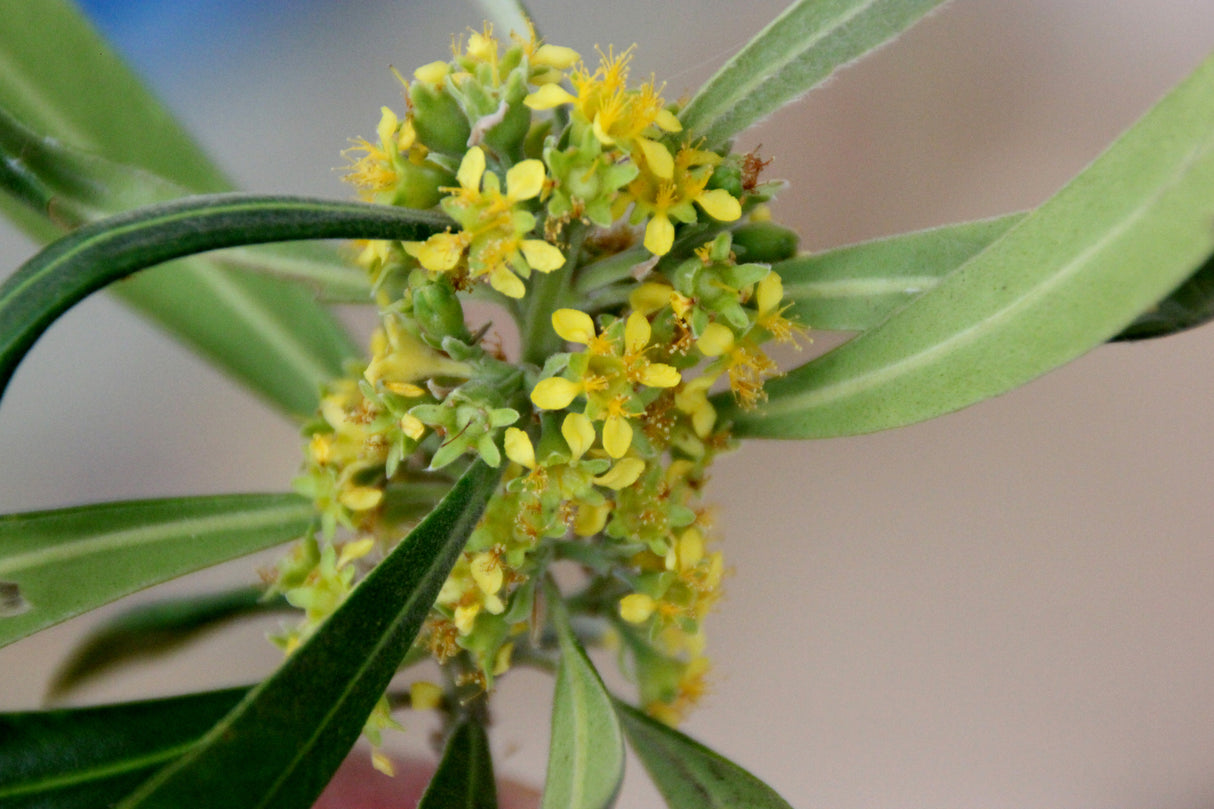Tristaniopsis laurina – Water Gum or Kanooka
The Tristaniopsis laurina, commonly known as Water Gum or Kanooka, is a versatile and attractive Australian native tree, celebrated for its glossy green foliage, smooth, mottled bark, and clusters of fragrant yellow flowers. This low-maintenance, evergreen tree is ideal for streetscapes, parks, and home gardens, providing shade, structure, and seasonal beauty.
Specifications:
- Height: 7–10 meters
- Width: 4–6 meters
- Native to: Australia (eastern regions)
- Foliage: Glossy, dark green leaves; evergreen
- Growth rate: Moderate
Conditions:
- Soil: Prefers moist, well-drained soils; tolerates clay and sandy conditions
- Light: Full sun to partial shade
- Water: Moderate; tolerates occasional flooding and periods of drought once established
- Climate: Thrives in temperate and subtropical regions
Additional Features:
- Flowers: Clusters of small, fragrant yellow blooms in late spring to summer
- Bark: Smooth, mottled bark in shades of grey, cream, and brown, adding year-round visual interest
- Form: Dense, rounded canopy providing excellent shade
- Uses: Ideal for streetscapes, shade trees, windbreaks, and native gardens
- Spacing: Plant 5–7 meters apart for avenues or standalone specimens
- Low Maintenance: Requires minimal pruning; remove deadwood to maintain form
- Pest Resistance: Generally pest-free and hardy
- Drought Tolerance: High once established; suitable for waterwise landscapes
- Frost Tolerance: Hardy to light frost
- Wildlife Attraction: Flowers attract birds, bees, and butterflies; provides habitat for native fauna
- Erosion Control: Effective for stabilizing soil along waterways and slopes
- Seasonal Appeal: Evergreen foliage and seasonal flowers ensure year-round interest
- Versatility: Complements native, modern, and formal garden styles
The Water Gum or Kanooka is a robust and visually appealing tree that offers both ornamental and practical benefits. Its adaptable nature, elegant appearance, and environmental contributions make it a favorite for urban and residential landscapes.
The Benefits Of Buying An Advanced Tree
The Process Of Transplanting A Mature Tree
Identify the Tree's Root Zone
Identify the Tree's Root Zone
Before you begin, it's essential to identify the root zone or root ball of the tree. This is the area where the majority of the tree's feeder roots are located. It is typically estimated as 1 foot of root ball diameter for each inch of tree trunk diameter.
Prune the Roots
Prune the Roots
Root pruning should occur a few months before the actual move, ideally in the dormant season. This involves cutting a trench around the root zone to encourage the growth of new feeder roots, which will help the tree to establish itself in its new location.
Prepare the Tree
Prepare the Tree
Prior to digging, prune dead or excessive branches from the tree. This reduces the tree's overall mass, making it easier to handle, and decreases water loss post-transplant.
Dig Around the Root Ball
Dig Around the Root Ball
After determining the root ball's size, begin digging around it. Try to retain as much soil around the roots as possible. The depth should ideally get under the root system but be feasible for lifting.
Undercut the Root Ball
Undercut the Root Ball
Once you've dug around the periphery of the root ball, begin undercutting to sever the remaining roots beneath it.
Lift the Tree
Lift the Tree
With the root ball freed, carefully lift the tree out of the hole. For large trees, this will likely require machinery like a tree spade or crane. Always lift the tree by the root ball, not the trunk.
Prepare the Tree for Transport
Prepare the Tree for Transport
Once the tree is out of the ground, it's critical to protect the root ball to prevent damage. Wrap it in burlap and secure it with twine, wire or steel basket. This not only holds the root ball together but also helps retain moisture.
Water the Root Ball
Water the Root Ball
Prior to transportation, water the root ball thoroughly to ensure the roots stay moist.
Transporting the Tree
Transporting the Tree
Load the tree carefully onto a truck or trailer for transport. The tree should be securely positioned to avoid damage during transit. The tree should ideally be planted in its new location as soon as possible to minimize stress and increase its chance of survival.


